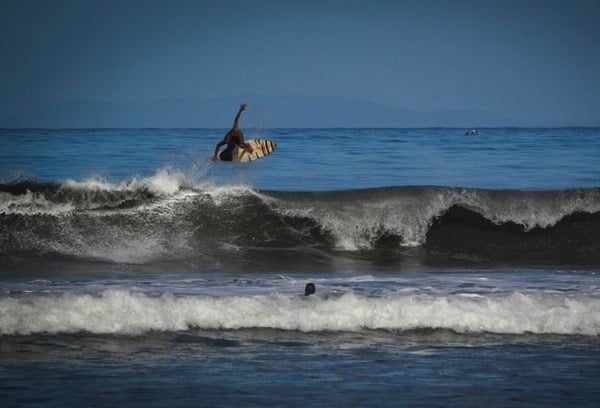

Not all waves are created equal—a fact all surfers will learn during their time at surf camp in Costa Rica.
Wind, swell and currents all contribute to wave formations. And while learning the difference between a closeout and a mushy wave may not seem high on your list of things to do, knowing the different wave types can help you to read surf conditions and become a better surfer, faster.
Read on for a breakdown of the 5 types of waves you’ll learn at surf camp in Costa Rica. (And for a primer on surfing terms, check out our article all about the anatomy of a wave.)
Closeouts
What it is: The term “closeout” refers to when the entire wave breaks at the same time. Closeouts offer no tapering curl or open wave face and create a lot of whitewater, making riding the wave impossible. The only option a surfer has on a closeout is to head straight for the shoreline. If possible, save your energy for better waves by avoiding them completely.
How it’s formed: Closeouts are caused either by strong off-shore winds or by the topography of the seafloor.
Mushy
What it is: Also referred to as “crumble” waves, mushy waves are slow rolling, gently breaking waves. Perfect for beginners, these waves lack speed and are not particularly steep.
How it’s formed: Mushy waves occur when a swell approaches a more gradual bottom contour.
Plunging
What it is: Also known as “tubing” waves, plunging waves break top to bottom, making them faster and more challenging to ride. Due to their difficulty, plunging waves are the type of waves that experienced surfers seek out.
How it’s formed: Plunging waves occur when a swell rolls through deep water before hitting a shallow sandbar or reef.
Reforms
What it is: Appropriately named, reform waves are waves that initially break, then die down as they pass through deep water before reforming and breaking again closer to shore. It isn’t unusual for more experienced surfers to ride the initial wave and leave the second break to less experienced surfers.
How it’s formed: Reforms occur when a deeper trench connects two shallow reefs or sandbars.
Double-ups
What it is: When two waves meet and their wave energy combines to create a larger more powerful wave. Double-ups can be dangerous when they break, causing trouble for even advanced surfers.
How it’s formed: Double-ups are formed when two waves meet with their troughs and crest aligned.
Surf Camp in Costa Rica
Ready to stop surfing the net and try your luck on water? School of the World, located in Jaco, Costa Rica, offers surf camps for beginners. Experienced local surfers teach the basics of paddling, standing and turning, as well as other fundamental skills like wave selection.
Already know how to surf and just looking for a little advanced instruction? School of the World also welcomes intermediate and advanced surfers looking to take their skills to the next level. Our Costa Rica surf camps range in length from one week to one month and beyond, and run year-round.
For more information, check out 5 Things You’ll Learn at Surf Camp in Costa Rica, and don’t forget to follow us on Facebook.
to reach our office directly +506.2643.2462
to reach a guest +506.2643.1064
U.S. number that connects to our office
+1-305-517-7689
schooloftheworld (skype)
to reach our office directly
+506.2643.2462
to reach a guest +506.2643.1064
U.S. number that connects to our office +1-305-517-7689
schooloftheworld (skype)